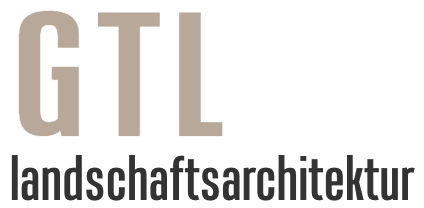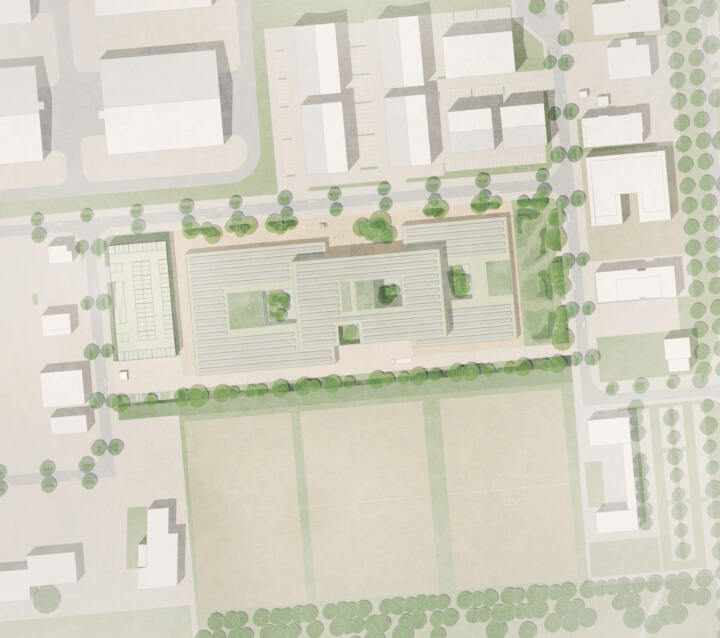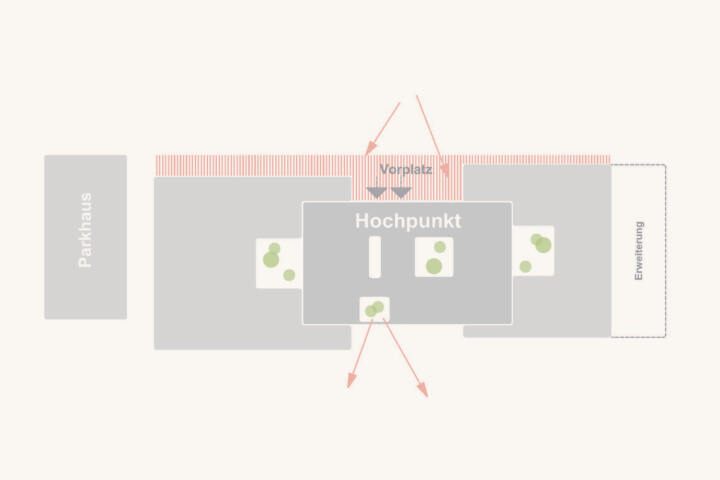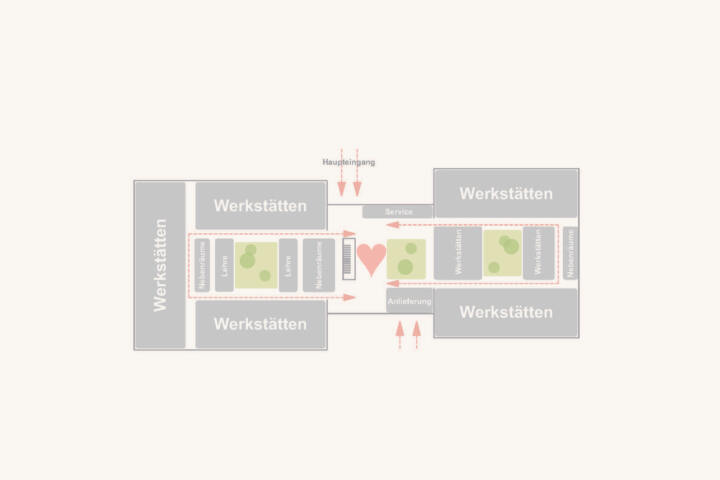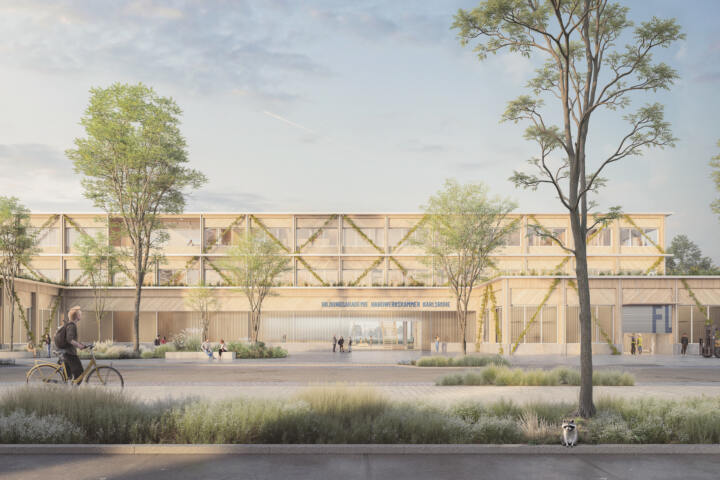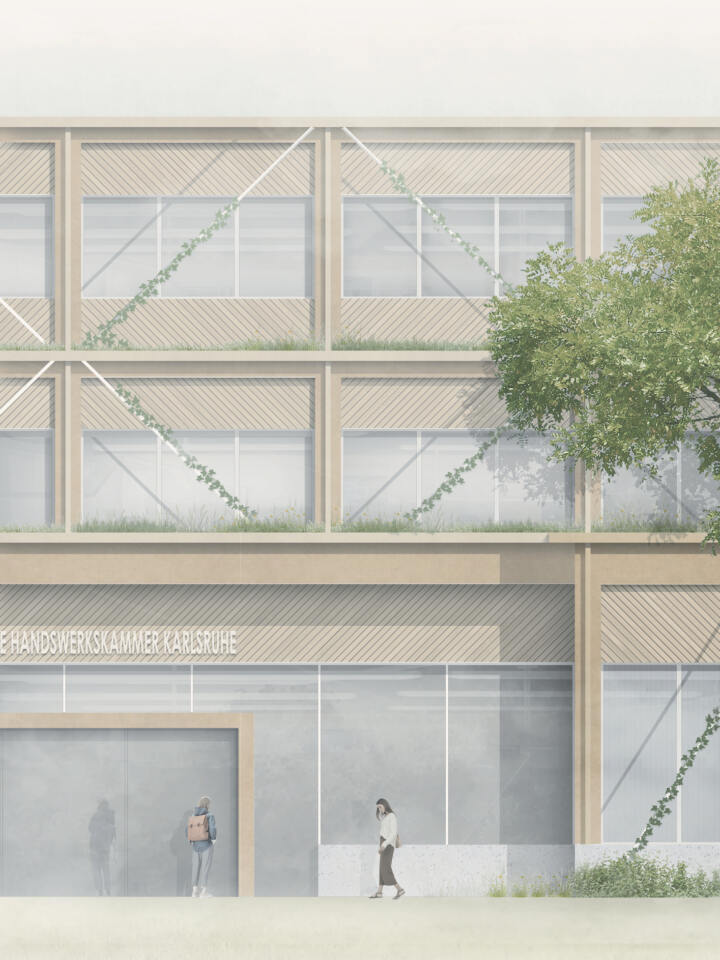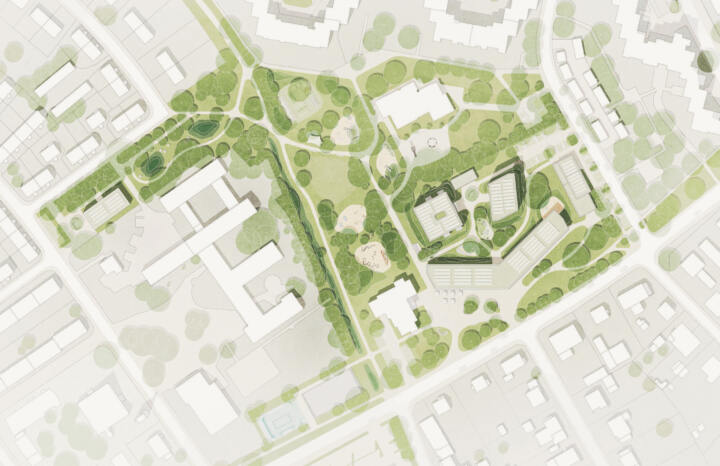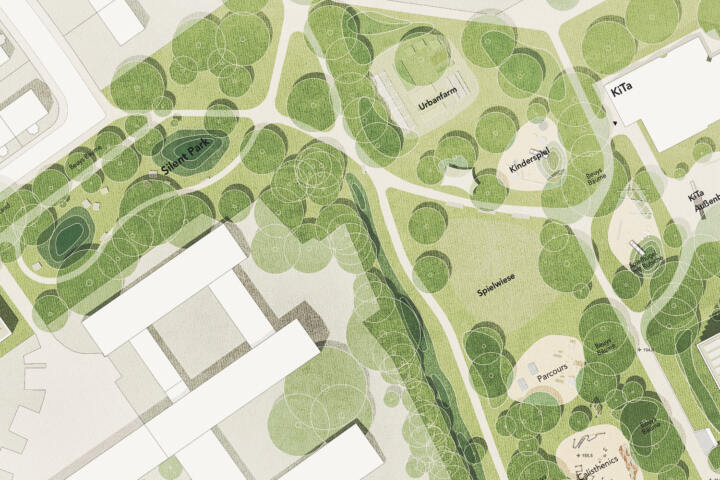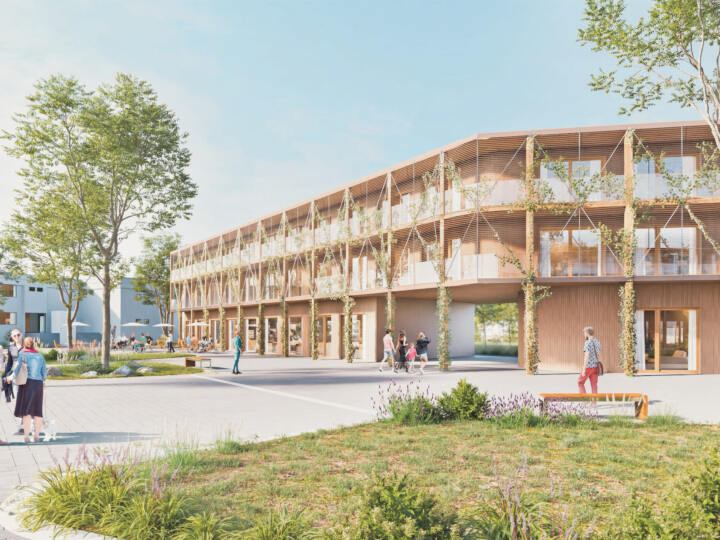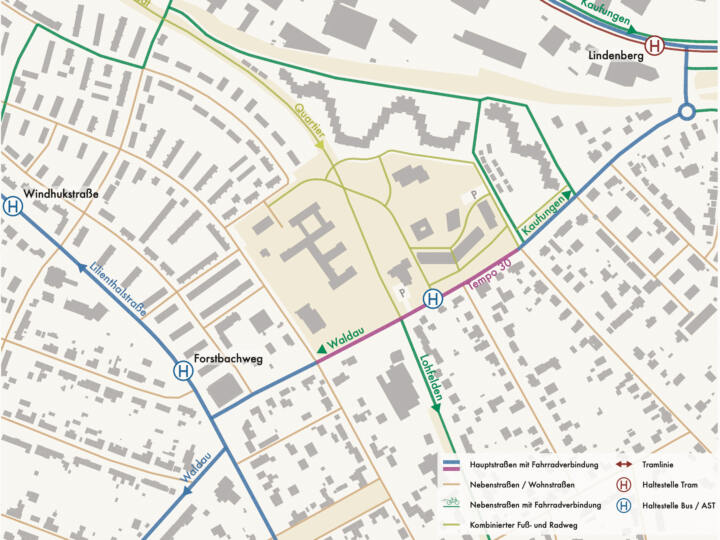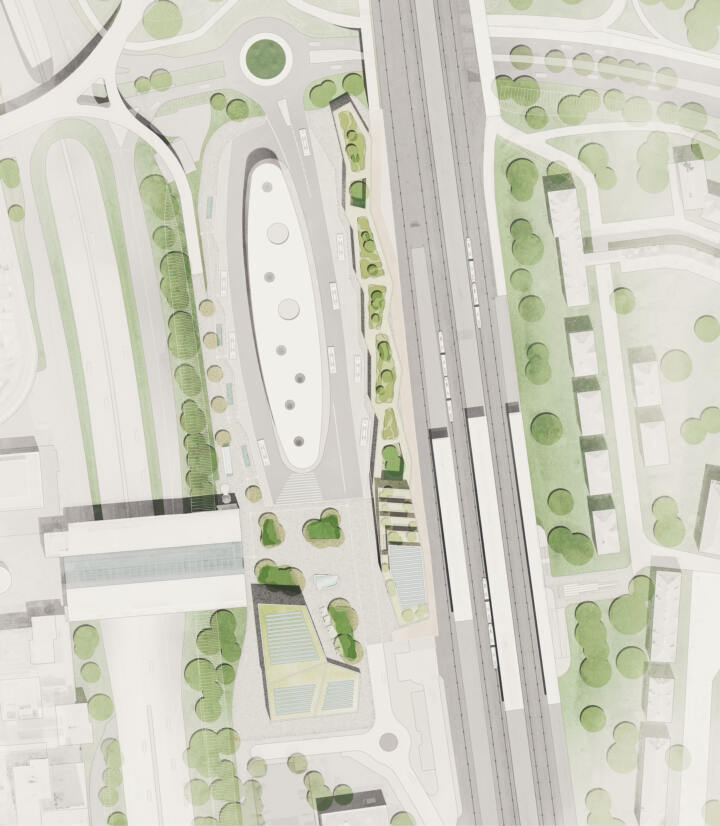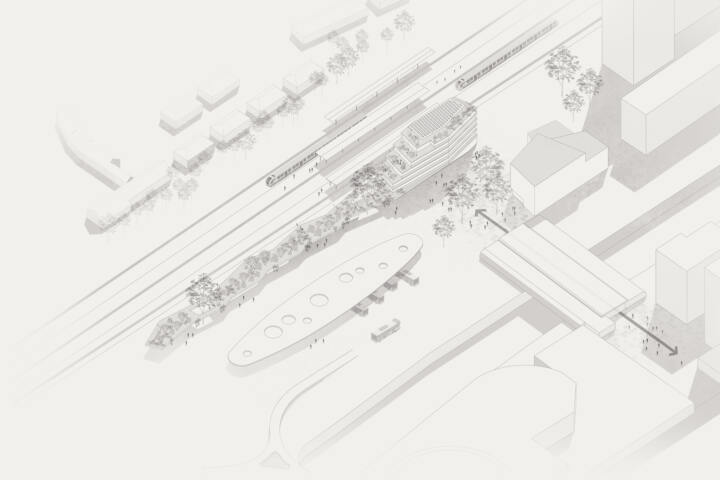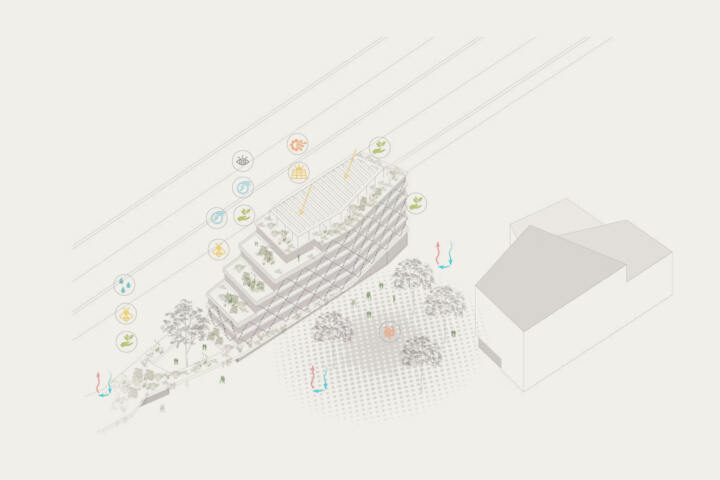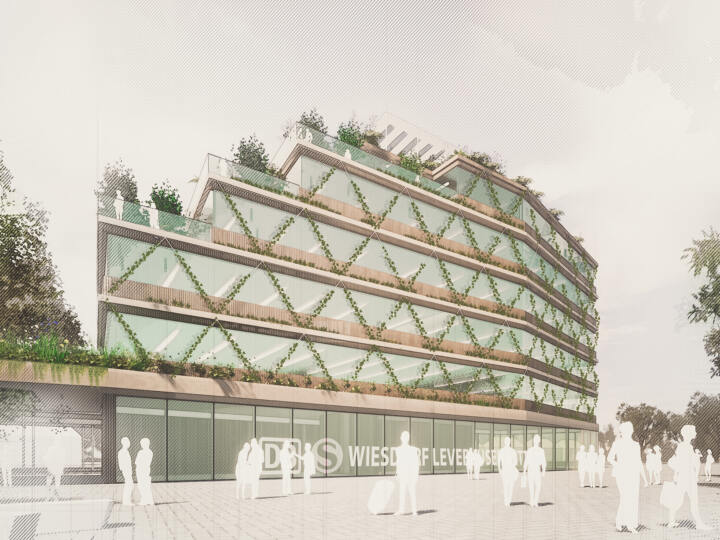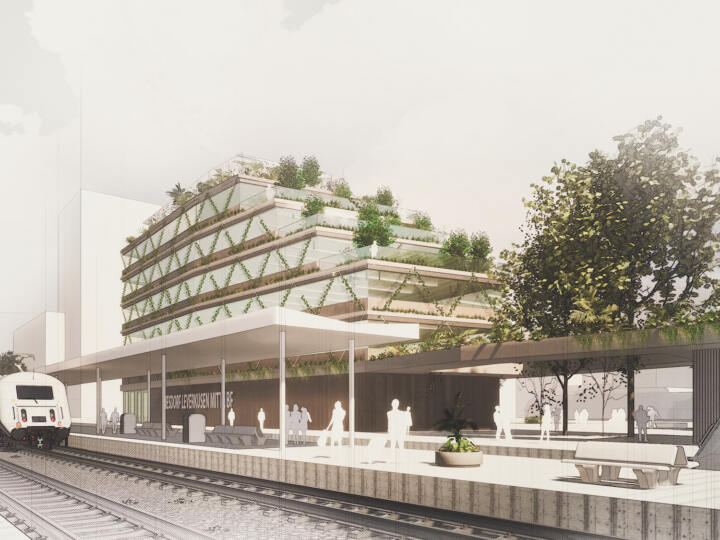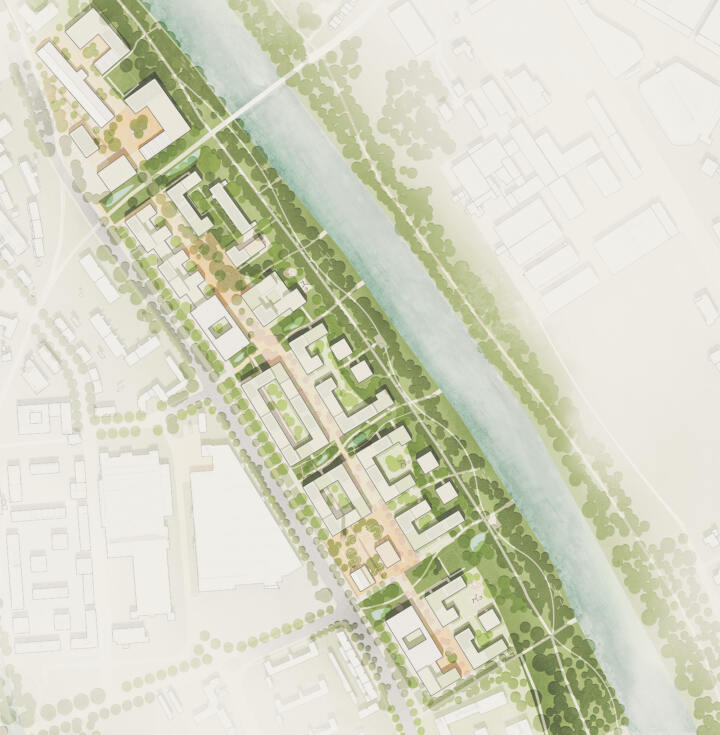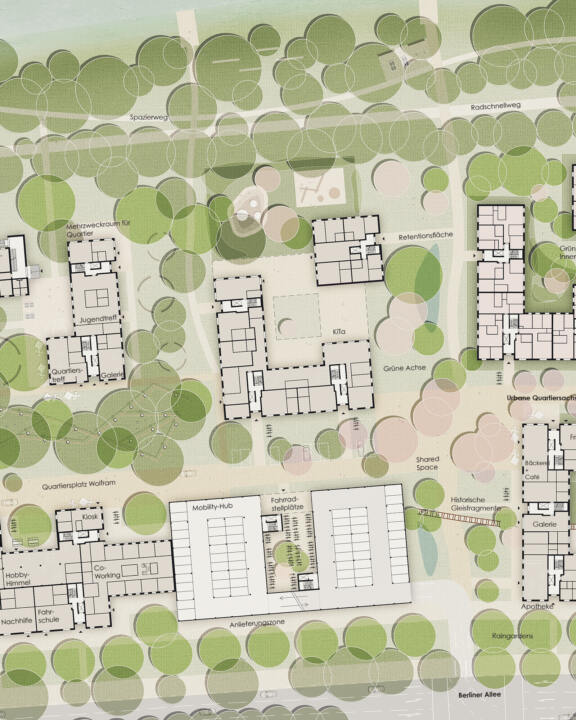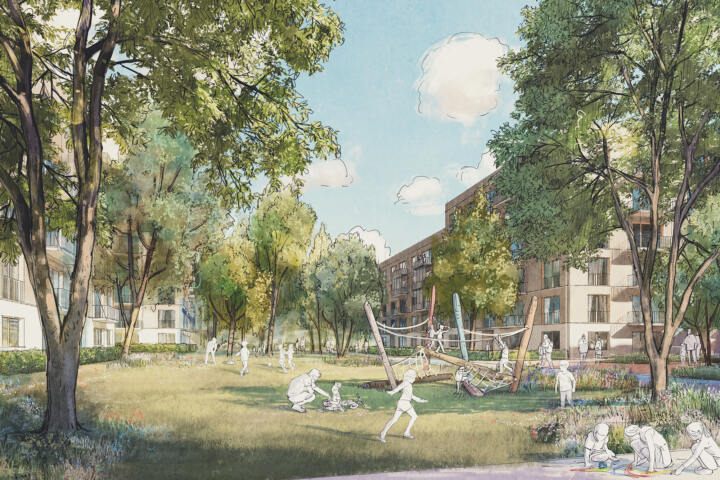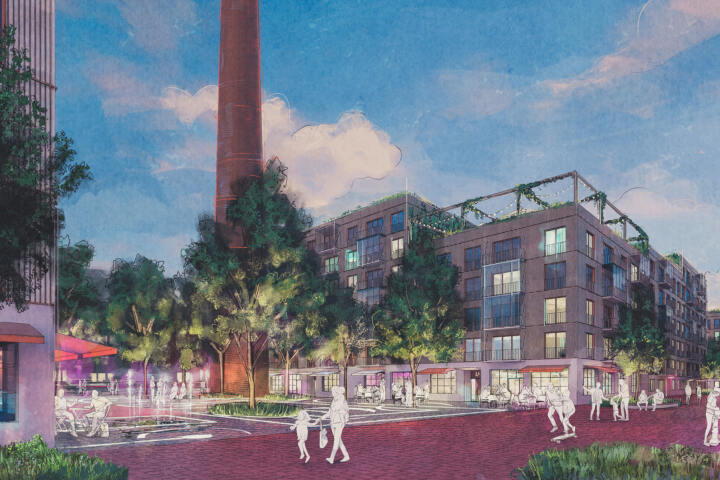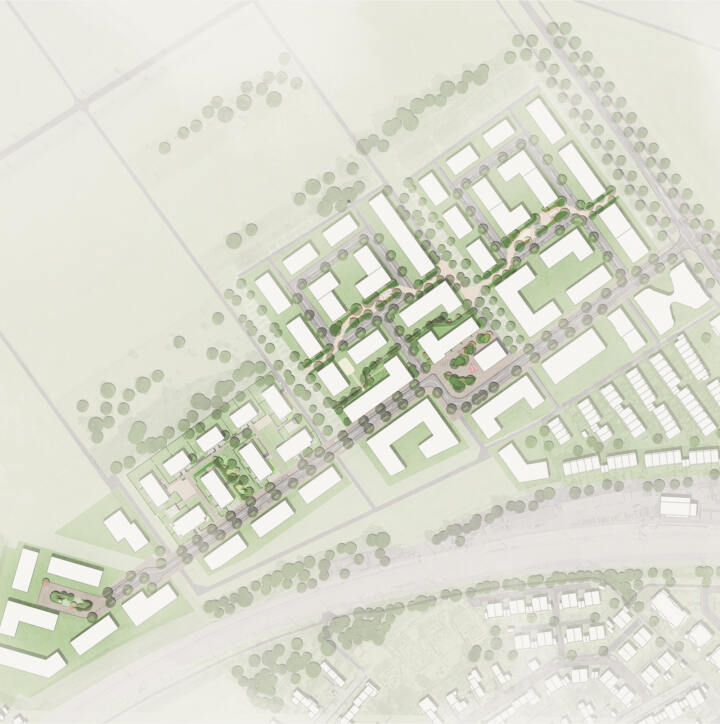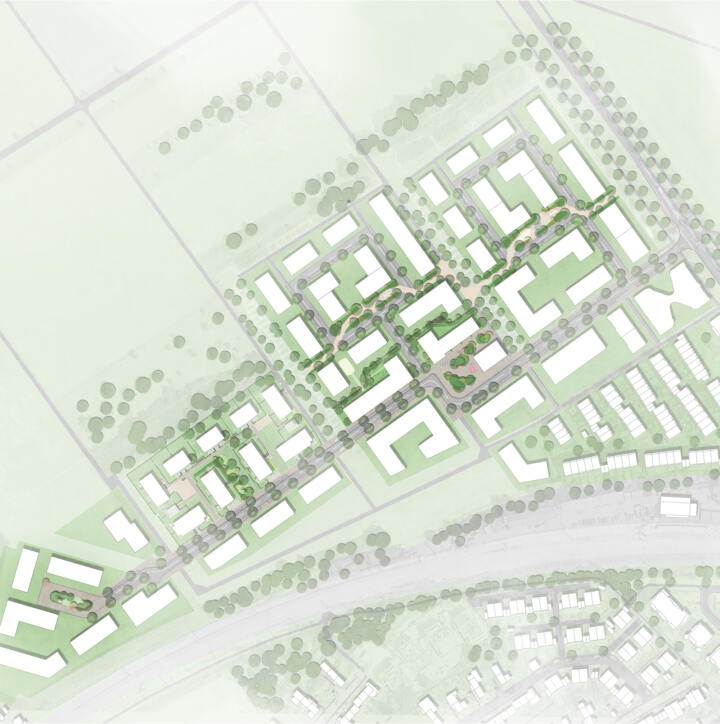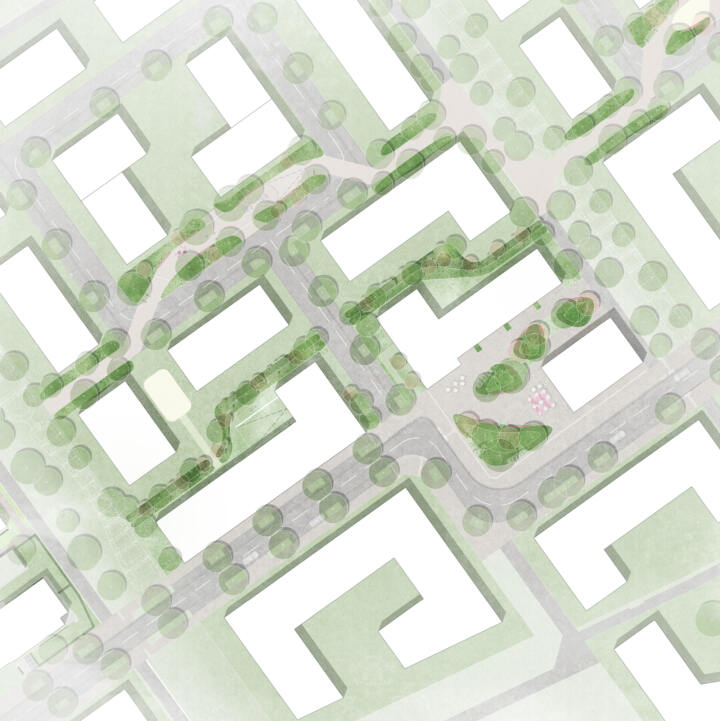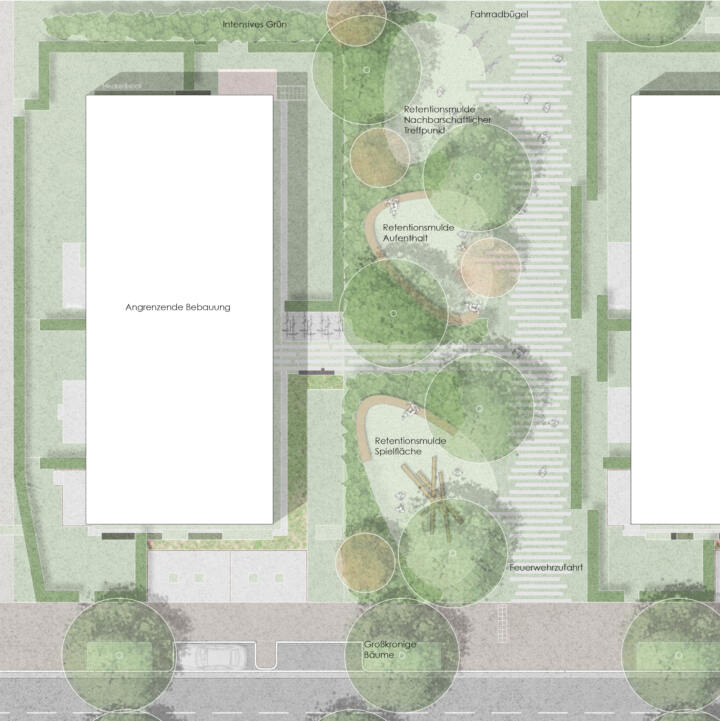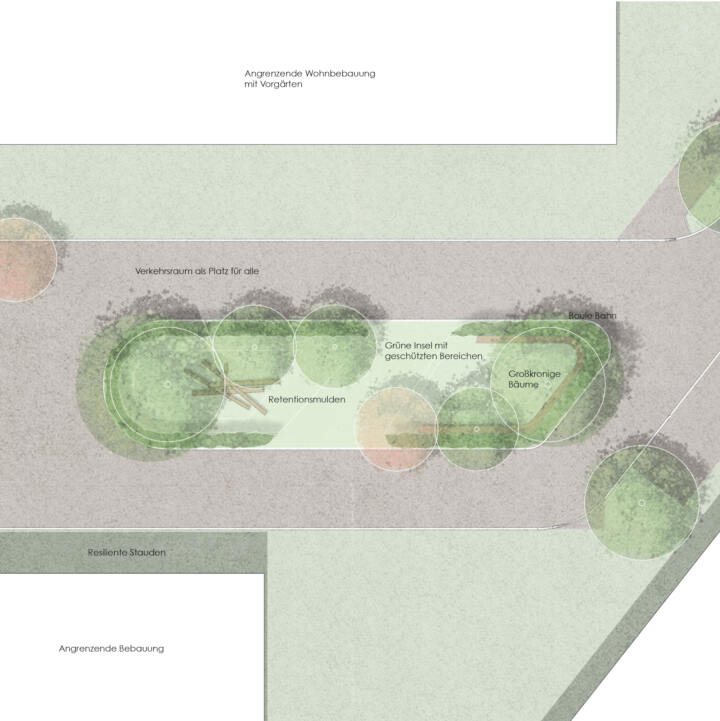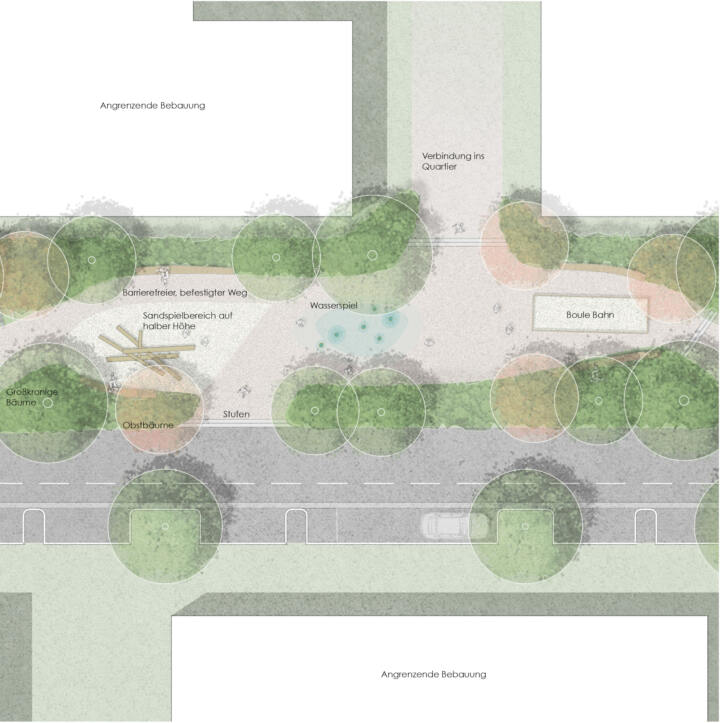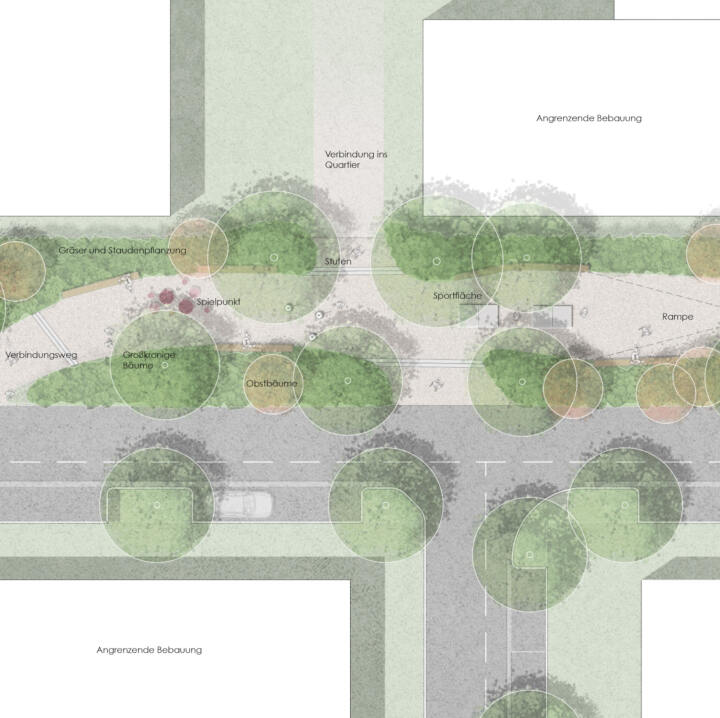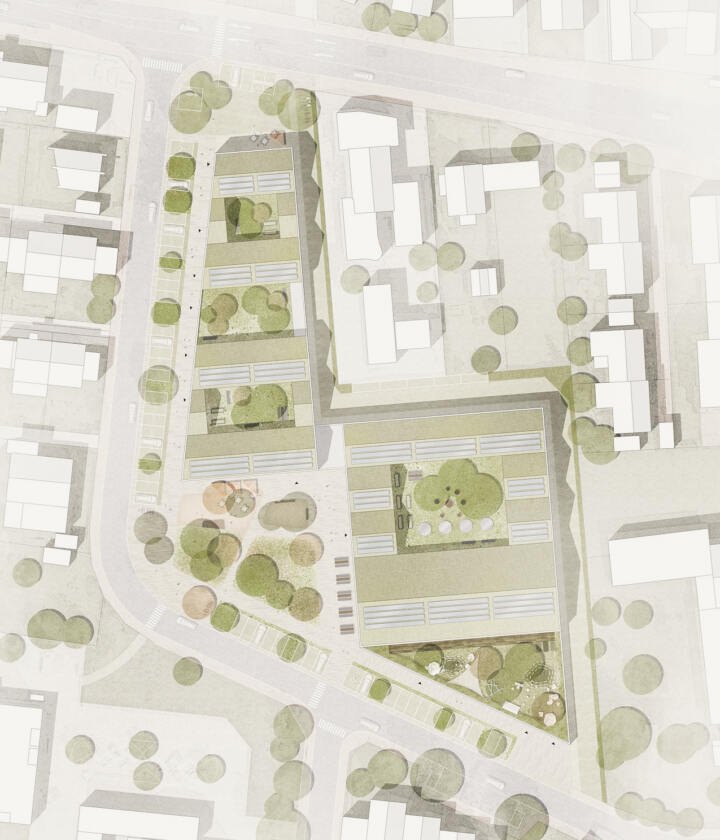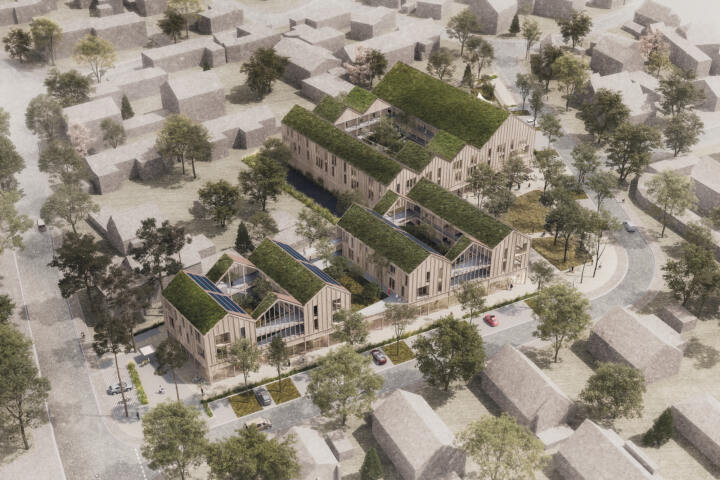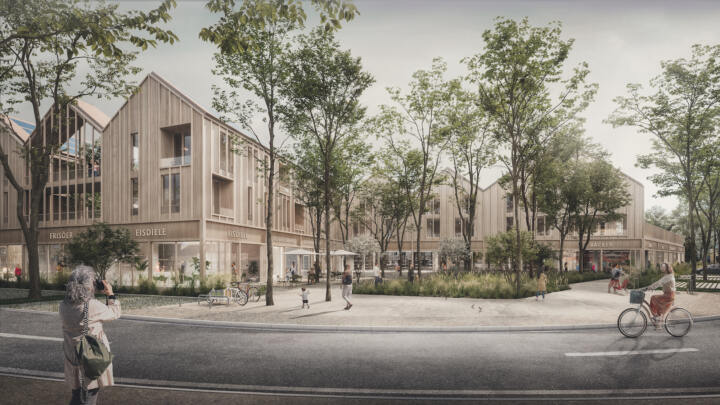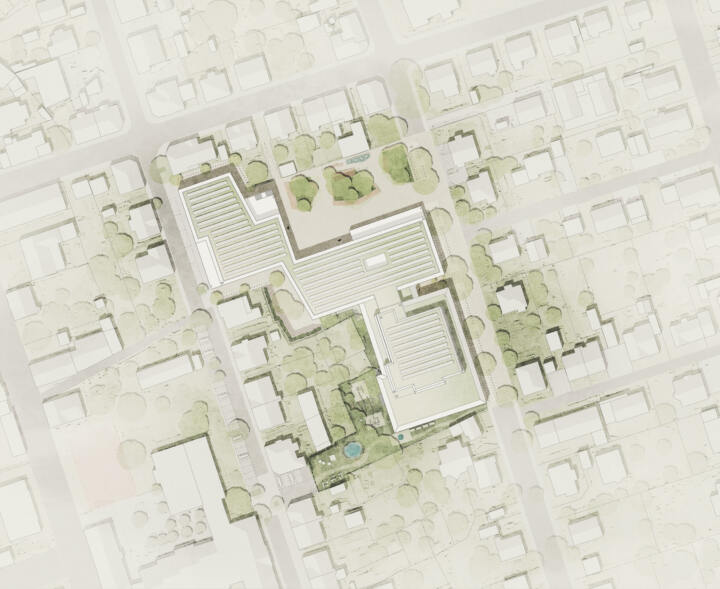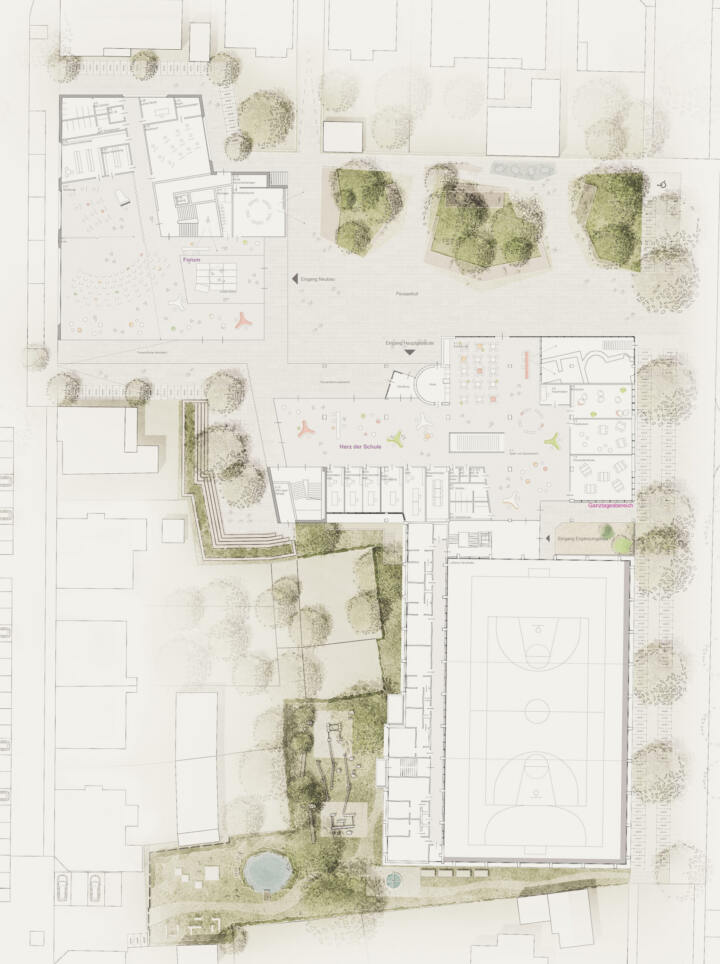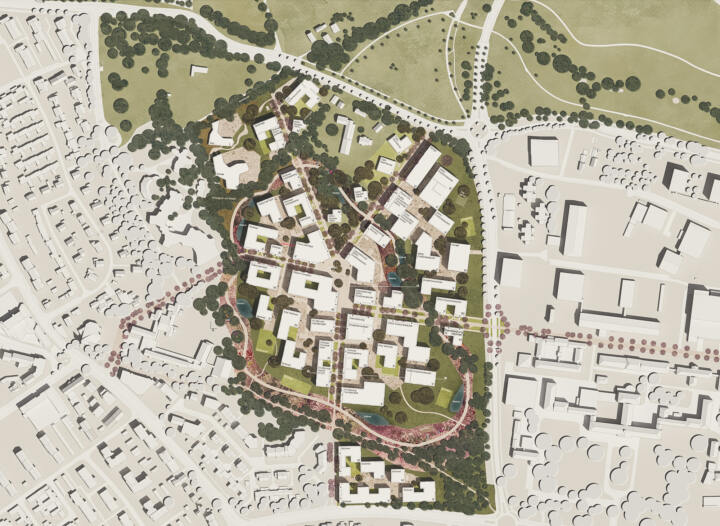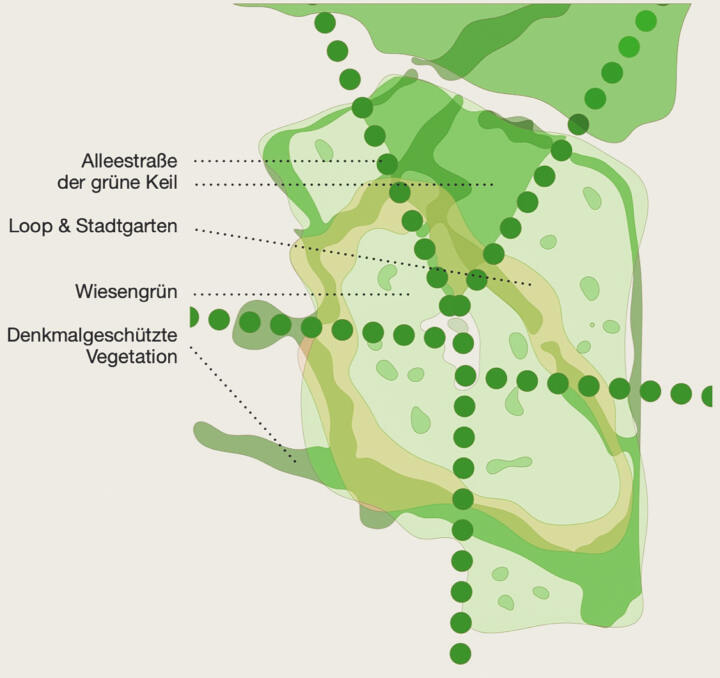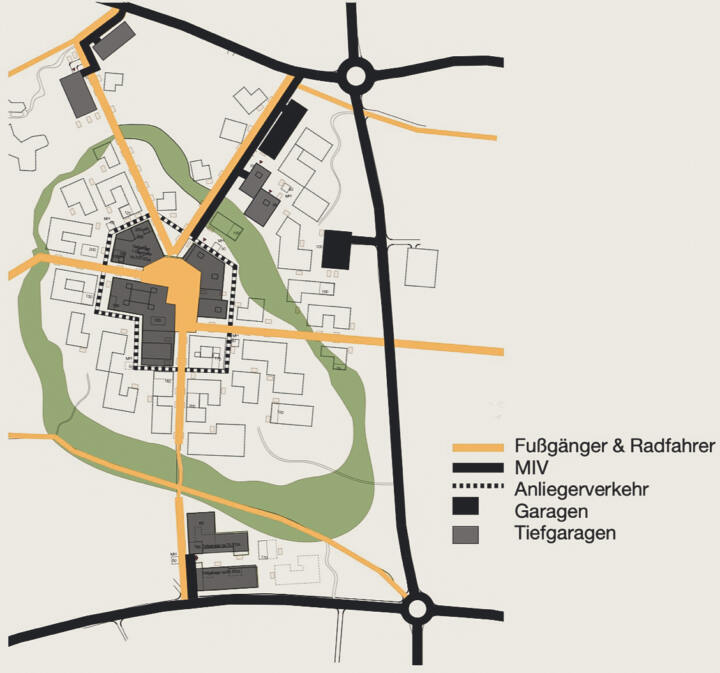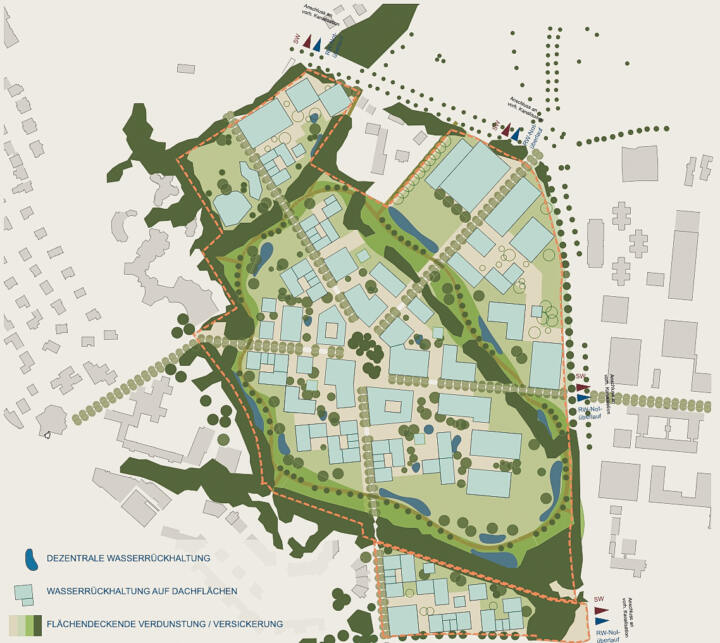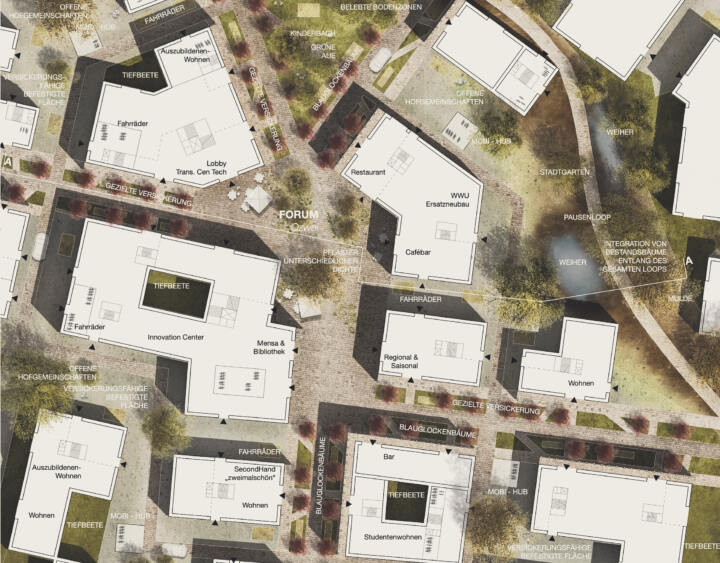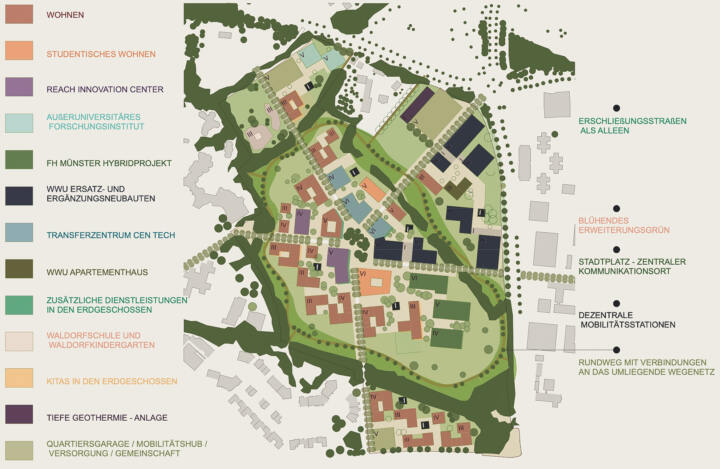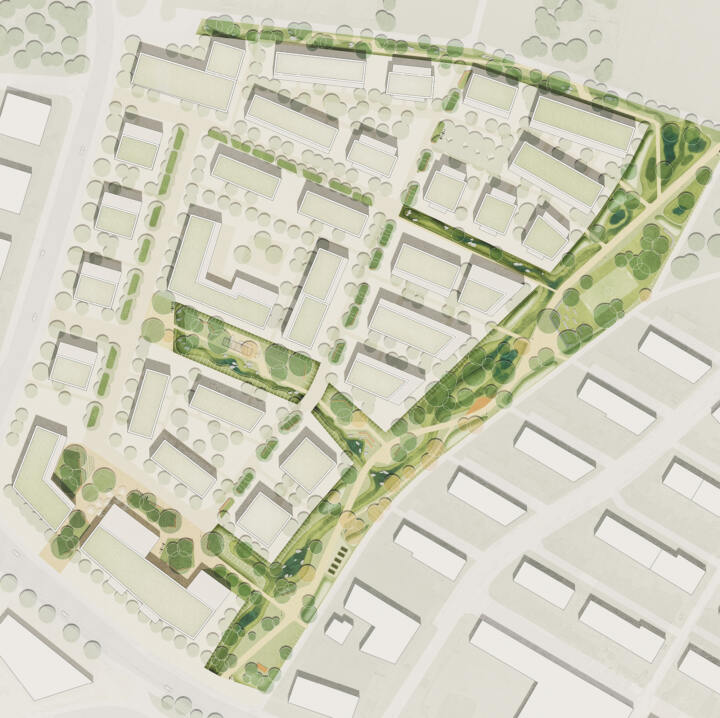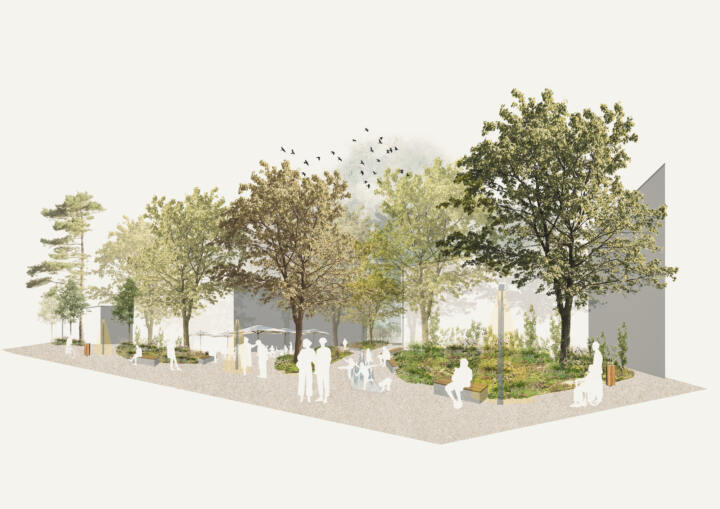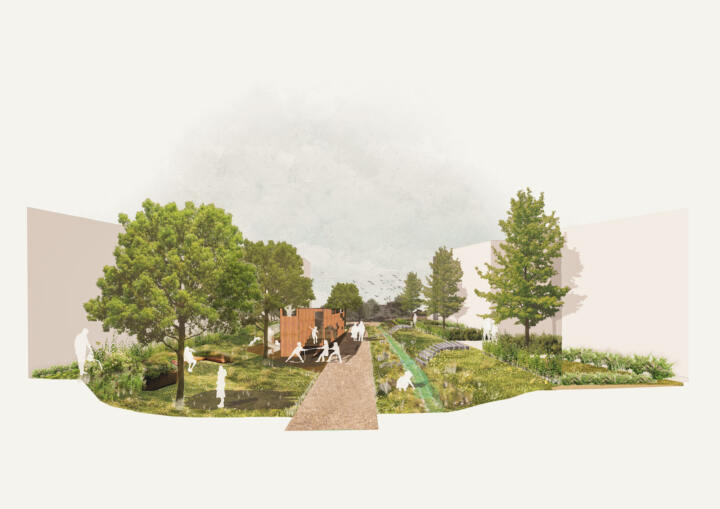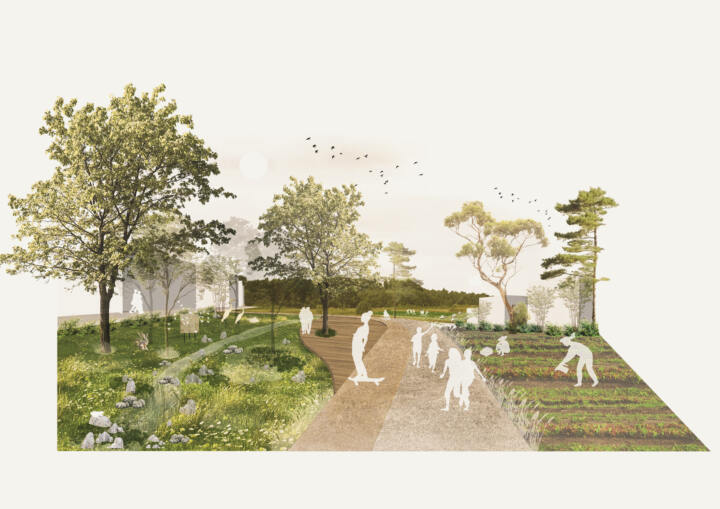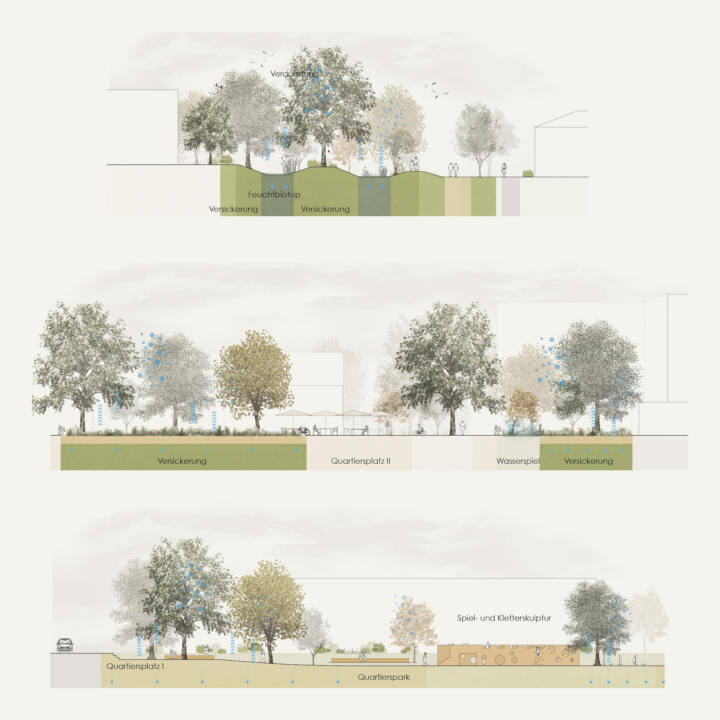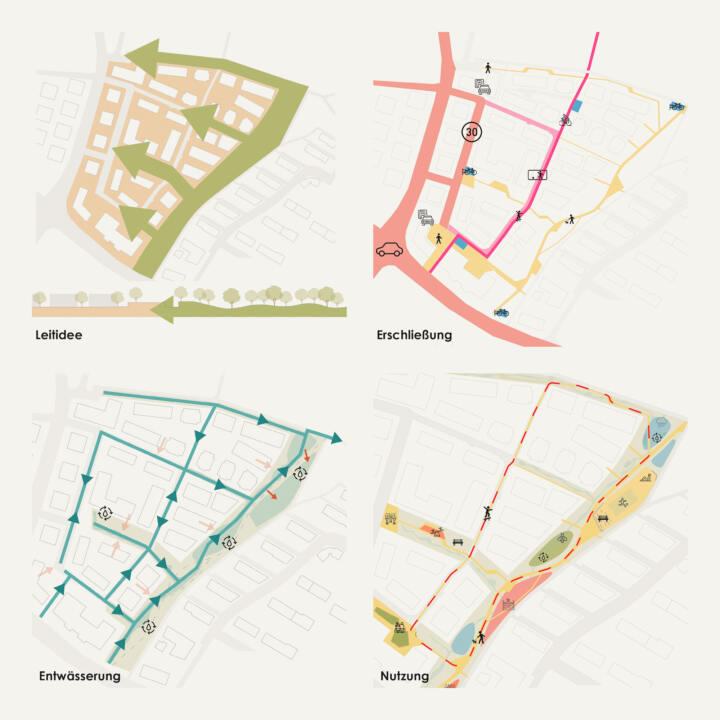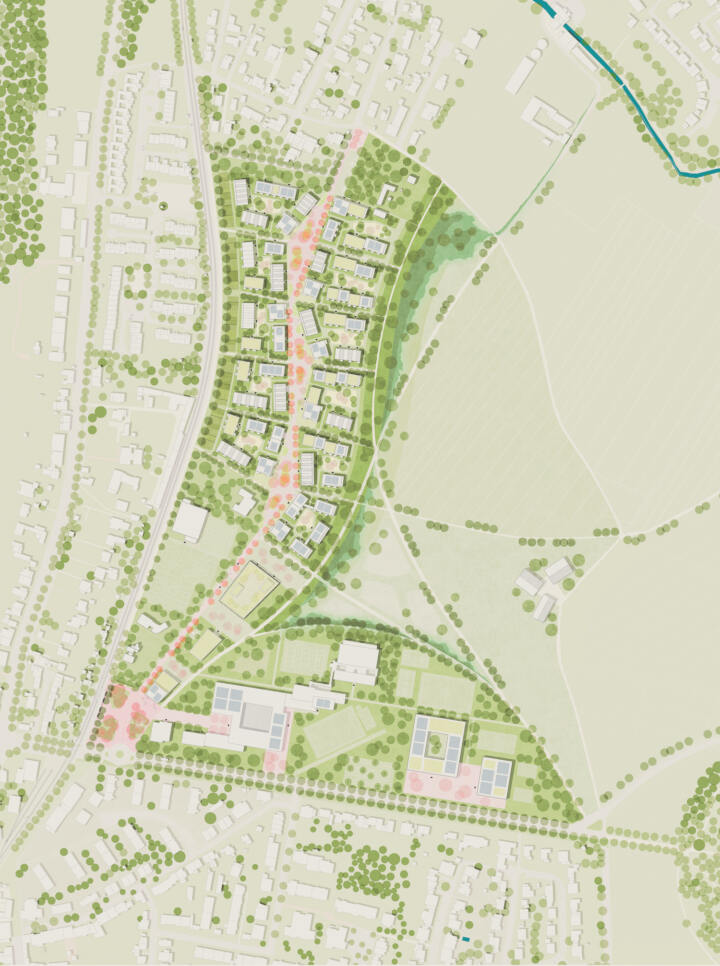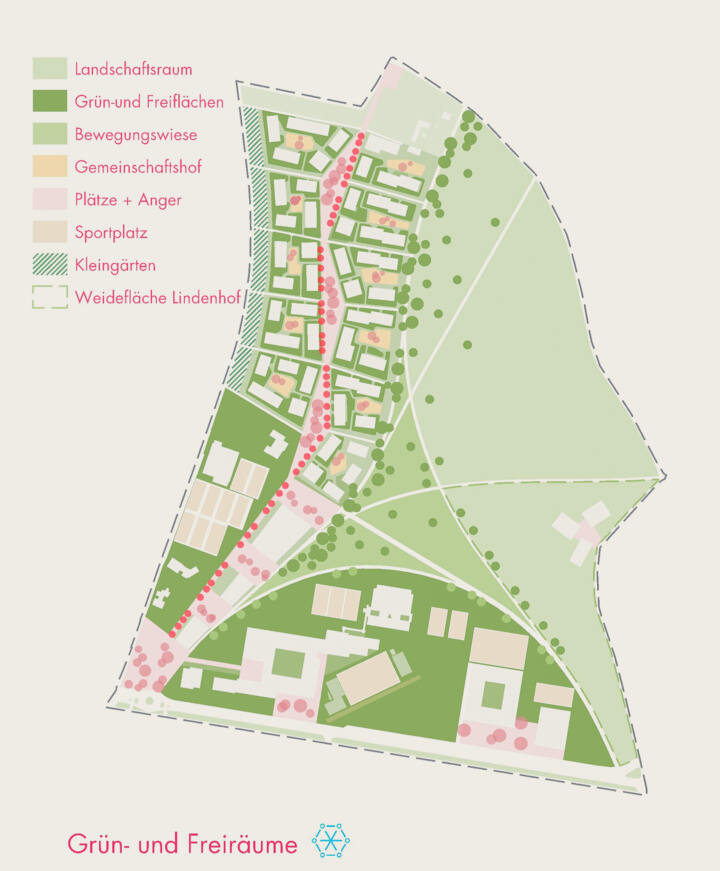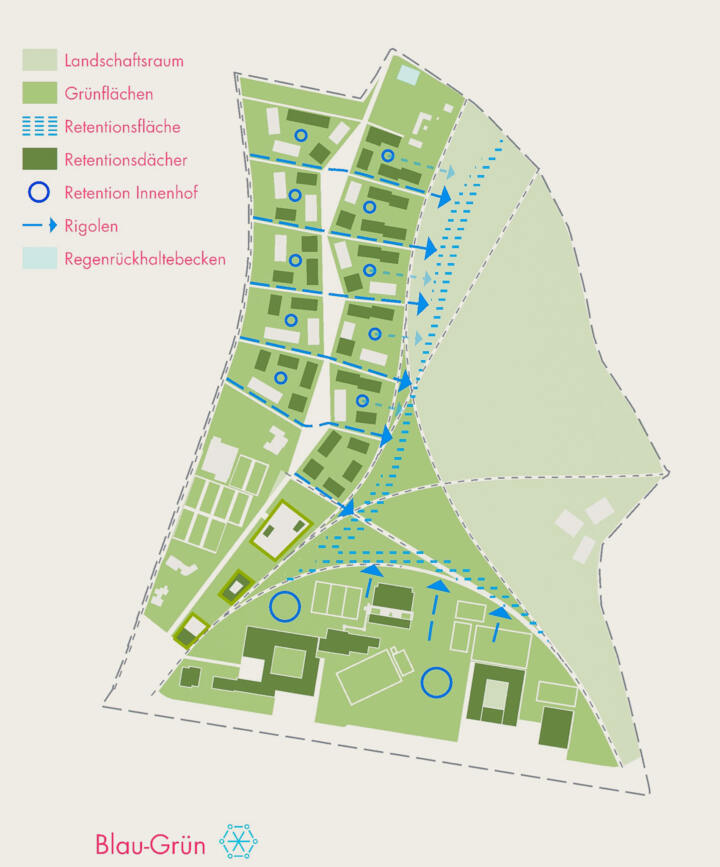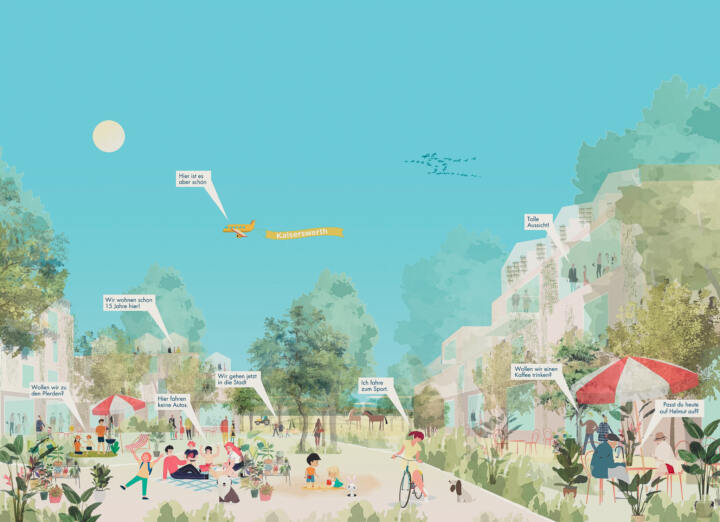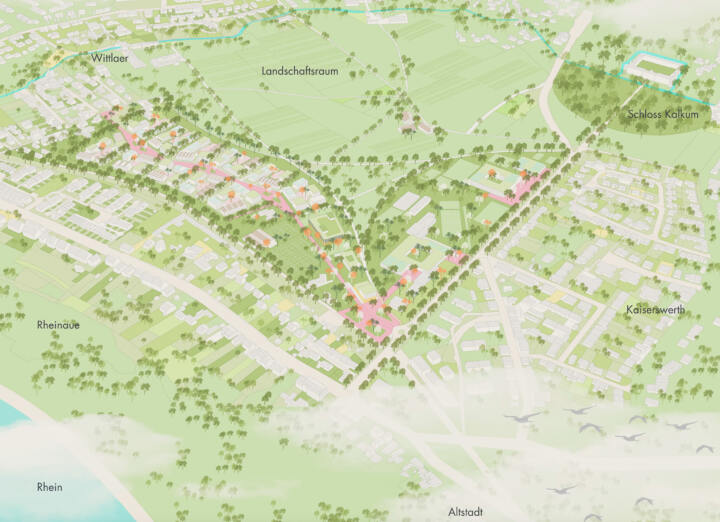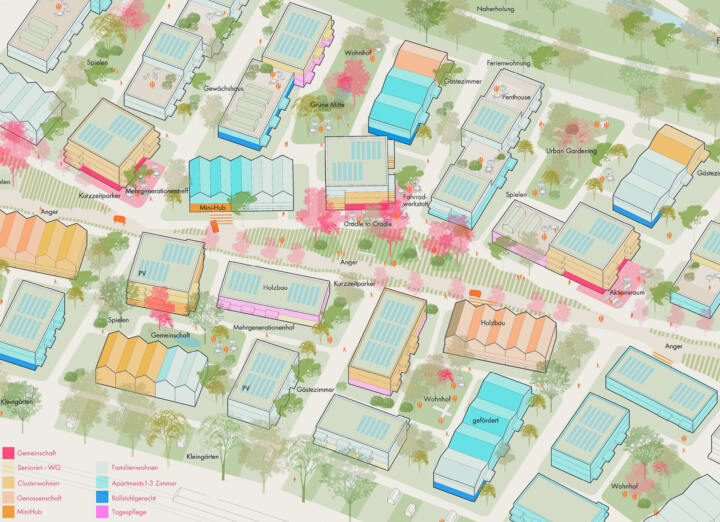New Construction of the Training Academy Chamber of Crafts Karlsruhe | Karlsruhe
Recognition | New Construction of the Training Academy Chamber of Crafts Karlsruhe
Karlsruhe
In collaboration with Atelier30
Urban planning idea
The new training academy gives the Karlsruhe Chamber of Crafts the opportunity to present itself in the context of constant economic, technological and social change with a new, contemporary and modern learning and working environment.
In accordance with planning and building regulations, the new building will be positioned along Johann-Georg-Schlosser-Straße. By staggering the structure, the building volume is structured and functionally organised.
The main entrance to the building is located in the centrally positioned, striking three-storey section of the academy, giving the educational academy an easily recognisable appearance that is appropriate to the location.
An entrance square is located in front of the main entrance, providing a short link between the car park at the side and the main entrance.
Inner courtyards
The workshops are arranged around central courtyards. This creates a varied circulation area with interesting views when moving through the workshop areas. In addition, widened areas in front of the courtyards and the courtyards themselves offer space for communication and relaxation.
Open space
The Bildungsakademie in Karlsruhe is reached via a spacious forecourt. Past small green islands and numerous trees, the entrance is clearly recognisable. A combination of greenery and seating areas creates an attractive place to meet and offers the opportunity to spend time in the urban centre under shady trees.
The collective relocation of the car parks to the western part of the site creates a calmer area in front of the academy for pedestrians and cyclists. This is reinforced by bicycle parking spaces in front of the entrance.
Deliveries are made via the southern open space. Together with the entrance to the petrol station, deliveries can take place separately from the rest of the Academy’s use. A strip of vegetation in combination with a fence restricts accessibility and creates a clear spatial separation. To further enhance this area, however, numerous trees will be planted. Small niches with seating areas are created under this tree canopy in combination with extensions of the green belt.
A central point in the outdoor area planning is the increasingly important rainwater management in order to ensure that the educational academy remains a modern location for many years to come. Generous retention and infiltration areas were therefore planned.
To the south of the new building, the retention area is located in a combination of several troughs. This allows excess rainwater from the site and neighbouring areas to be collected, evaporated and seeped away.
A green belt around the car park deck also allows some of the rainwater in the western part of the site to be absorbed. The remaining water is channelled into the long infiltration area to the south.
The three inner courtyards with green and seating elements also support the handling of precipitation through direct infiltration areas.
Roof and façade design
The roofs of the single-storey building areas and the storey ceilings of the central building are planned as timber-concrete composite ceilings on a construction grid of 5x5m. If required, the construction grid can be extended to 7.5×7.5m or 10x10m and the construction supported by beams.
The façade elements and interior walls are planned in timber frame construction.
The materiality of the façade continues the timber construction method. The façade surfaces are clad with timber panelling. Greenery is proposed for parts of the façade.
Biodiversity and rainwater management
In addition to the functional requirements of the educational academy, the open spaces also fulfil fundamental functions of resilient and sustainable area development. Rainwater management, water-permeable surface paving,
vegetation areas rich in structure, biodiversity and cohabitation take centre stage here.
centre stage. The building roofs will be intensively greened with regional seeds. The 30 cm thick substrate layer retains rainwater almost completely through storage and evaporation. Excess rainwater from the roofs is collected in cisterns and made available as service water for the building services and the green areas.
The outdoor areas are provided with a comprehensive rainwater management system. For this purpose, the rainwater is channelled into the planting or shrub areas so that it can be collected there and seep away locally. Excess rainwater during heavy rainfall events is channelled into retention areas.
The open green spaces, with a large proportion of species-rich flowering zones, with heat-tolerant extensive shrubs and grasses, serve as food and habitat for bees and insects. Free-growing hedges of native trees and shrubs are planned along the edges; they form the boundary of the space, reduce noise and provide protection. Interspersed fruit trees increase the biodiversity of the open space. A green space for people, animals and plants.
Forstfeld-Centre | Kassel
2. Preis | Forstfeld-Centre
Kassel
Multiple commissioning in collaboration with Baufrösche
Key idea
The urban design for a district centre combines a targeted building configuration with the existing buildings, striking groups of trees with an inviting green neighbourhood square along Forstbachweg.
Urban development and open space
The Boomerang House for meeting, education and living forms the new district centre with a neighbourhood square and park along Forstbachweg thanks to its urban design, together with the youth centre and the gymnasium and multifunctional hall. The planned greening with old and new trees contributes to the creation of an inviting, versatile and protected open space. The ground floor of the Boomerang building is intended for communal, social and commercial uses in order to revitalise the centre of the neighbourhood and visibly promote social interaction. The tower and the atrium house complete the collage and together form a green, semi-public residential courtyard. This residential courtyard can be further enlivened by spacious communal areas on the ground floors, making it ideal for communal living models. A spacious passageway in the Boomerang House connects the open, park-like courtyard with the neighbourhood square. The TOGO House at the end of Togopark forms a striking spatial accent, provides social security and utilises the existing unused brownfield site for residential and commercial use. The noise-intensive uses for a ball sports field and a skate park are being created on the school grounds along Forstbachweg and, together with the supermarket, now complement the new Forstfeld centre along Forstbachweg. These measures will help to reduce noise pollution in the neighbouring residential areas.
Development
Car traffic in the entire neighbourhood will be significantly reduced in order to prioritise public open and green spaces as high-quality recreational areas for the residents of the Forstfeld district. Forstbachweg will be converted into a 30 km/h zone in some areas (e.g. Leuschnerstraße). The existing access road and the car parks for the daycare centre will be removed and relocated to Heinrich-Steul-Straße. The areas of the existing car parks will be converted into outdoor play areas for children. The resulting elimination of the break between the youth centre and the adjoining areas will make a significant contribution to moving the Forstbachweg building into the urban context and onto the neighbourhood square. The required parking spaces will be provided in a short cul-de-sac and along Heinrich-Steul-Straße. If required, an underground car park can be built under the tower house. Bicycle parking spaces are provided in the open space with hangers and a lockable bicycle shed. In addition, the lifts in the residential buildings are suitable for bicycles, so that bicycles can also be parked safely and conveniently in their own cellars. It is possible to cycle through the new centre of Forstfeld at a speed of 10 km/h. As the Boomerang House is only planned with three storeys and the tower house and the atrium house will be equipped with safety staircases, no complex fire service bypasses are necessary.
Open space and ecology
The urban development concept results in a high proportion of green spaces with characterising grove structures in the existing buildings, sophisticated new planting and attractive squares. Of particular importance for the concept of the open spaces is the neighbourhood square with a high quality of stay and the connection between the open spaces.
The generous green spaces and the preservation and planting of new trees fulfil the increased need for urban greenery due to climate change. These measures serve as a buffer against heat stress and heavy rainfall events and also act as a dust filter. Wherever possible, rainwater is channelled into open retention basins and made visible. At the same time, the run-off of rainwater from the roofs is minimised by using green roofs as buffer storage.
Further development of Bahnhofsquartier | Leverkusen-Mitte
2nd prize | Further development of Bahnhofsquartier
Leverkusen-Mitte
In collaboration with Atelier30 Architekten
Key idea and urban development concept
The new station building with adjoining bicycle parking garage marks the new station entrance and access to the tracks with an appropriate high point and sets an example for the Wiesdorf/Leverkusen-Mitte station district. At the same time, the new development forms the transition and an appropriate prelude to the south to the newly developed post office site.
The cubature of the station building develops, stepped down like a terrace, out of the single-storey long building of the bicycle parking garage. The development is characterized by intensively greened roof and façade areas and represents a visible contribution to urban development. The bicycle parking garage is subdivided into several parking areas. The angled arrangement of the bicycle boxes defines the space towards the central bus station and yet does not place the bicycle highway in the second row. With the new possible crossings, the cycle highway is connected to the central bus station/station square and not relegated to the second row behind the bicycle parking garage as a mere “through lane”. The cantilevered roofing in the area of the first floor offers protection for additional bicycle parking spaces and the possibility of storage. The building can be constructed in two separate parts.
Open space concept
Opposite the large traffic area of the bus station, the new station forecourt acts as a green link between the unvegetated functional area – the new station and office building and Rialtoboulevard. The interplay between paved surfaces, tree-covered areas of grasses and shrubs and a water feature means that the square not only fulfills its function as a high-traffic transit space, but – equipped with robust street furniture – also becomes an attractive place for waiting people, strollers and visitors to the restaurant. As the adjacent traffic areas are expected to become even hotter in the future, the station forecourt outside the movement areas will be covered with large-crowned, shady trees, which, in combination with the evaporative cooling effect of the fountain, promise a significant cooling effect. The roadway for the buses in the square area will be made of in-situ concrete with the same aggregates and the same color nuances as the pavement in order to ensure a consistent, uniform overall impression.
Lighthouse area | Augsburg
Recognition | Lighthouse area
Augsburg
In collaboration with REICHER HAASE ASSOZIIERTE
Green and open spaces
Starting from the protected green strip along the Lech, they extend the tree structures far into the neighbourhood and thus connect the urban and green spaces with each other. Green corridors will be created between the buildings in an east-west direction, drawing the greenery right up to Berliner Allee and thus extending the green space from the Lech not only into the neighbourhood, but also into the city. This will also have a positive effect on the warming of the city in summer, as the corridors will transport fresh, cool air from the river.
In order to design the corridor as effectively as possible, the centre will be kept clear, but the tree positions will become denser towards the edges so that the adjacent facades do not heat up and this warm air would reduce the positive effect.
In the green corridor along the Lech, an additional footpath will be created so that cycle and pedestrian traffic do not share the same path. Along the walkway, there are always small places that invite you to linger by the water or in the green strip. Table tennis tables and calisthenics complete the leisure programme here. In the summer months, a bathing area can also be created by the water.
Public green spaces
The green corridors that run through the neighbourhood from east to west form the public green spaces. Play and sports facilities are created in the open centre. Benches invite people to linger and meet. A central path connects the neighbourhood with the open space on the Lech.
Private green spaces
Within the residential neighbourhoods, courtyards are being created in which private green spaces are located directly next to the buildings, separated from the communal garden by shrubs and hedges. In the communal areas, there are opportunities for communal gardening, playing and spending time outdoors.
Squares and streetscapes
The boulevard, which runs through the entire neighbourhood, connects all areas with each other and represents the inner development axis. The space is flanked on both sides by green spaces that extend from the buildings into the boulevard to varying degrees. This gives the entire space a green appearance. The carriageway meanders through these green spaces.
The four neighbourhood squares lined up along the boulevard have different functions. Osramplatz forms the prelude to the neighbourhood. This is an urban square with cafés, benches and open spaces for markets and events. In the evening, the planted areas here shine in a special light and form circles on the ground. Further south is the smaller Ledvance neighbourhood square. Neighbourhood get-togethers take place here. LED panels in the ground shine here when the square is in use. Wolframplatz will have a special highlight. An illuminated wire spans between the existing trees, creating a special atmosphere in the evening hours. Another square is being created between the workshops in the north. Here, craftsmanship takes centre stage. Small exhibitions and markets will be held here.
Trees and plants
All existing trees in the neighbourhood will be preserved in order to use the quality of the already established trees. The existing trees will be supplemented by planting climatic trees. These are characterised by the fact that they can cope with extreme rainfall and waterlogged soils, but also with longer periods of drought. To avoid having to replace the soil for each tree planting, the site is partially backfilled with the existing material. This gives the trees sufficient root space without having to completely remove the old backfill. When selecting the plants, attention is paid to shallow-rooted species. A species-rich planting of shrubs in front of the residential buildings offers both protection for residents and a habitat for many bird and insect species. The green axes are accompanied at the edges by plantings of shrubs and grasses, which require little maintenance due to their lush and dense growth.
Resilient perennials and grasses are planted within the infiltration troughs, which recover quickly even after long periods under water and also survive longer dry periods well.
Rainwater management
In order to create a sustainable neighbourhood, it is primarily important to unseal the surfaces as extensively as possible. This can create a natural climate with infiltration and evaporation directly on site. However, due to the pollution of the soil in the neighbourhood, this is associated with high costs. The design envisages directing rainwater from the neighbourhood into the designated troughs, where the water can collect and seep away. In these areas, the soil is replaced down to below the layers of backfill so that the rainwater can seep unhindered to the groundwater. In order to channel the rainwater into these troughs, the rest of the site will be partially raised.
Raingardens will be created in front of the buildings facing Berliner Allee. The rainwater from the footpaths and cycle paths and the excess rainwater from the roof areas will be channelled into these areas. Thanks to the revitalised soil layers, the cleaned water can seep into the groundwater or evaporate again on the surface. In the event of heavy rainfall, the trough formation allows water to accumulate and gradually seep away.
The roofs are greened and designed as low retention roofs. This means that rainwater can be retained on the roofs and is available for plants and evaporation.
Hilgenfeld | Frankfurt
3. Prize | Hilgenfeld
Frankfurt
In collaboration with dirschl.federle architekten
‘Living with green loggias’ is the leitmotif of our design. The green spaces of the Hilgenfeld connect the neighbourhood and integrate the loggias of the flats.
Building B3.2 with commercial and residential units responds to the square in front of it. It forms a head situation at the corner of the square, in which a publicly accessible use with an effect on the square was to be accommodated.
The public open spaces, which are spread across the entire neighbourhood, offer the opportunity to create a green connection between the individual residential areas. This creates an important cross-connection with isolated widenings and squares that increase the proportion of greenery and offer additional recreational areas and meeting points.
Green spaces
Green spaces, in particular areas with trees, have a positive effect.
Fine dust reduction, pollution control, shade and a cooling effect are the measurable values. But spending time under a tree canopy, sitting in a meadow, gardening together, the aesthetic effect, the pleasant odours of flowers and fruit are just as perceptible as they are beneficial.
When selecting trees and shrubs, care should be taken to ensure that they are not sensitive to the changing conditions caused by extreme summer temperatures, periods of drought, heavy rainfall etc. at the site. Open tree discs and the planting of trees and tree trenches underneath lead to a significant reduction in surface runoff, while at the same time increasing infiltration and evaporation values.
Nourishing shrubs and nesting and breeding opportunities are provided for “green diversity” within the planting areas. When selecting the trees and shrubs, climatic trees will be excluded. Special trees such as the hop hornbeam and the bluebell tree are planted in the squares. In this way, the areas differ from one another and always offer different highlights throughout the year. The flowering and fruiting of the trees is also taken into account in order to provide food for insects and birds. The habitus of the trees is chosen so that they create a large shaded area, especially in the traffic areas.
Rainwater
In the spirit of the sponge city concept, the aim is to keep as much rainwater as possible on site, allow it to seep away and/or evaporate and thus positively change the climate in the neighbourhood in the long term. Where possible, rainwater is therefore drained away via the green spaces. In addition, the lowered square areas provide retention volume for heavy rainfall events. Only excess water is released into infiltration channels. The increased number of trees planted is a key factor. The trees provide shade in the summer months and thus sustainably reduce heating, they absorb rainwater and release some of it again through evaporation.
Spaces and uses
With their elongated shape, the two squares P 2 and P 3 form the southern end of two sub-areas in the new neighbourhood. These public communal areas are intended to be understood and used as green transitional and connecting spaces: direct access from the neighbouring areas to the north means that neighbourly life and play are offered here in the immediate vicinity of the living space, and these green spaces also connect the sections of the neighbourhood with each other in an east-west direction. The lush green setting creates a protected space that nevertheless remains open and inviting. Accessible via ramps and steps, the recessed areas offer space for play and sports as well as various places to spend time. Due to its slightly lowered position, the square is an important component of the rainwater concept. In the event of heavy rainfall, the rainwater can be temporarily stored so that it can then evaporate and seep away over unsealed surfaces. Squares P 4 and P 5 will be designed in the same way. Here, too, intensively planted areas will be created with play and recreational facilities. In area P 4, the paved area for the fire brigade will be reduced to the essentials; necessary traffic areas and planted areas will interlock and form soft transitions.
The neighbourhood is invited to meet here on the long benches in the shade under the trees. The small square P 5 forms an island within the necessary turning loop. As very little traffic is expected here, the entire street space can be designed as a square. The inner area forms the green centre. Hedges create a retreat here and large trees provide the necessary shade for the paved areas. Retention areas are also generated here
Rainwater is collected in the recessed areas of the squares and seeps away or evaporates. Integrated or neighbouring plants are selected with a view to tolerating longer dry periods and temporary water accumulation.
Cornflower Square forms the heart of the neighbourhood. Commercial areas and cafés are located here, giving the square a special significance as a place to spend time. The central idea of bringing plenty of greenery into the neighbourhood is also continued here. The green spaces extend across the square and at the same time form a frame towards the street. The areas planted intensively with shrubs and grasses are supplemented by infiltration troughs at the edges. The centre of the square is deliberately kept open to provide space for events such as flea markets. Small drinking fountains offer the opportunity for refreshment and play. 2 cafés line the edges of the square.
Local Supply | Göttingen
2. Prize | Local Supply
Göttingen
In collaboration with pape+pape architekten
The open space concept of the new local shopping centre is defined by generous open and green spaces, which lead to a transformation of the place in which the car is no longer in the foreground.
The spatially sophisticated building design integrates further green spaces into the building itself. The inner courtyards on the first floor take numerous other opportunities out of the buildings to make the centre even greener.
The forecourt opens up the local shopping centre to the neighbourhood and develops into a public square for everyone. The significant reduction in paved areas allows water to seep away more easily and fits in with the sponge city concept.
The preservation of the existing trees and the planting of additional deciduous trees and fruit trees are particularly important for this, but the use of grass paving for the car parks also contributes to this. The remaining paved areas will be fitted with light-coloured concrete block paving.
Numerous seating and recreational areas will also be integrated, which can be found at the café in the north or at the neighbourhood square.
The roof garden and inner courtyards also create a special place to relax and meet with seating and vegetation.
In addition to car parking spaces, particular emphasis is placed on a large number of bicycle parking spaces. Bicycles can be parked at various locations; cargo bikes and e-bikes of all kinds can also be charged and parked, making the local shopping centre modern and inviting. This is supported by parking spaces for car sharing, micro and light vehicles and areas for mixed use.
The daycare centre’s raised garden, which is located on the first floor and protected by wide shrubbery, is particularly noteworthy. In addition to play hills and play elements, there are also other deciduous and fruit trees here, which, in combination with beds in the raised garden and inner courtyard, invite children to plant and eat their own food.
Eugen-Bolz-Secondary School | Rottenburg
Recognition | Eugen-Bolz-Secondary School
Rottenburg
In collaboration with Atelier 30
The existing school area is implemented in a structurally heterogeneous environment.
The new heart of the school landscape is located in the forum of the new building. The central space, which includes a gallery, offers many possibilities for use by the school community.
The future traffic development consists of a successful mix of motorised private and public transport, as well as cycling and pedestrian traffic. With the exception of a few barrier-free parking spaces, cars are parked outside the school area and the existing school grounds are implemented in a structurally heterogeneous environment.
The urban positioning of the buildings on Eberhardstrasse is orientated towards the important footpath connection in the direction of the public transport stops, and opens up the schoolyard in a meaningful way, which, as in the existing building, connects to the footpath in the direction of Sophienstrasse in the north (barrier-free access via a ramp) and opens up towards Mechthildstrasse.
The sections of the open spaces correspond closely to the new school building. The forecourt, which opens onto the street, leads directly into the “heart” of the school campus, the central courtyard between the old and new buildings. The fact that a large part of the courtyard is underpinned by a bunker requires raised planting beds for the necessary tree planting. Chill and learning decks alternating with seating steps turn the resulting raised beds into meeting places during breaks and free periods. The cubature of the raised beds is orientated towards the building structures and creates flowing, semi-open spaces that allow individual occupation of the courtyard while maintaining the necessary clarity. A partially covered area for learning and working at group tables and benches is provided in the northern part of the courtyard, somewhat separated from the break area.
The large playground offers sufficient space for exercise, especially for the younger age groups. The existing exercise facilities to the west of the gymnasium will be supplemented by additional facilities such as calisthenics equipment and parcours elements.
In addition to the requirements of the exercise and learning landscape, the open spaces also fulfil fundamental functions of resilient and sustainable area development. These include a maximum of structurally rich vegetation areas, water-permeable surface paving and rainwater management as a circulation system. All roof surfaces of the school buildings are intensively greened – an approx. 20-30 cm thick layer of substrate stores the rainwater and makes it available to the plants. Where possible, rainwater from the paved areas is channelled into the drainage and storage layer of the raised tree beds and also collected in cisterns for the use of service water.
Busso-Peus Street | Münster
Recognition | Busso-Peus Street
Münster
Concept ❘ A centre, a network full of character, a ring path and the existing, extended vegetation form the basis of the concept for Münster Model Quarter 2. This “nature hybrid” is intended to be an international demonstration project for how sustainable housing and university construction can be combined with intensive reforestation, increased biodiversity and circular resource thinking in a suburban and peri-urban area. Dense and socially networked neighbourhoods are created. What is important is an urban structure in the centre that provokes education, exchange and community and expands along the “avenues”.
The urban-natural landscape ❘ The city and the university merge into a dense sub-centre. The existing vegetation becomes the starting point for a park – for an urban-natural landscape. The urban development project is intended to become a laboratory for the development of a close symbiosis of living and working environments in areas close to the city and help the city of Münster to realise its ambitious nature and climate protection goals. The overlapping of uses will enable a new urbanity on the outskirts of the city. A centre and structural density, consistent networking with the surroundings, the strong framework of tree structures and a mule track through the intensive natural garden are the basis of our concept for Model Quarter 2 in Münster.
Open space concept ❘ A central square forms the heart of the new neighbourhood – a forum. This is where the opportunities for exchange, learning and research are concentrated. Open courtyard communities that form around the central square merge into the landscape. Their informal design allows for diverse appropriation and is characterised by the “open” green surfaces.
The neighbourhood is also surrounded by an open landscape area with meadows for play and sport and additional space for animal enclosures and the learning garden.
A flowering perennial field with a walking path and jogging track surrounds the Allende. This serves as a break and after-work diversion and connects the individual courtyard communities.
Existing rows of trees of the natural monuments remain untouched, are supplemented and form a spatial setting. The Appelbreistiege will be crossed carefully and with narrow bridges over the existing ditches. This crossing is kept to a minimum and is designated exclusively for pedestrians and cyclists.
The green corridor along the Kinderbach stream in the north of the site will be brought right up to the central square of the new neighbourhood. This will provide the existing courtyard complex and even smaller individual buildings in the neighbourhood with a lush green environment.
Path and traffic concept ❘ Star-shaped avenues open up the site. They connect to the existing network of paths and meet in the centre of the site. They connect the new district with neighbouring areas such as the research campus, Münster’s city centre and the centre of Gievenbeck. The most important connection is the route from the city centre via the research campus to the centre of the new quarter. The junction with Busso-Peus-Straße is emphasised by a circle of trees and the new buildings on the west side form a gateway to the new quarter. Of the total of five access roads, four are intended exclusively for pedestrians and cyclists. Each street is lined with green spaces and framed by the buildings.
Coming from the north, from Gievenbecker Weg, motorised traffic will be routed to the central square under the underground car park. Delivery, emergency and refuse vehicles can drive through the neighbourhood on a ring road. The courtyard communities can be delivered via the gravelled lawn areas.
Drainage concept ❘ The design follows the principle of the “sponge city” with the components of evaporation, storage and infiltration of rainwater. If the surface materials allow a low level of evaporation or infiltration, the rainwater that accumulates on the open spaces is channelled to troughs and deep beds via suitably designed open ditches or via cross-slopes created on the paths and squares. These are designed for a high evaporation capacity through appropriate planting, in some cases with trees, and are designed in such a way that they also improve the quality of stay and the microclimate.
In addition, retention areas are used for the temporary storage of rainwater for delayed reuse. Part of this is utilised for water storage and groundwater recharge via infiltration trench systems, tree-riogole systems and additional underground systems.
Brunnenquartier | Karben
Recognition | Brunnenquartier
Karben
Open space concept ❘ The Brunnenquartier in Karben will be a future-oriented residential neighbourhood characterised by its blue-green infrastructure. One key component is the green corridor, with areas of park to the north and east. This interconnects with the neighbourhood in the form of green fingers of varying widths and lengths, and so offers an open space of enhanced quality and easy accessibility. For the neighbourhood itself, in terms of its proximity to Frankfurt and a direct connection to rail transport, there is great potential for development.
Neighbourhood squares and green corridors I The green corridors both frame and run through the neighbourhood, with curved paths linking up the key locations in a natural way. The paths are flanked by similarly curved retention basins that widen several times along the way to form wetlands. The concept envisages that not only the rainwater that accumulates in the park is collected, seeps away and evaporates here, but rainwater from all the surrounding residential neighbourhoods too. This will create watercourses and extensive areas of water after heavy rainfall, which, in addition to being ecologically beneficial, will also encourage visitors to play and linger. During periods of normal rainfall, only a few puddles form within these troughs; during longer periods of drought, they lack water altogether, resulting in a constant flux from wet to dry hollows. The selection of resilient plants emphasises precisely these characteristics. Even in dry hollows, the planting also indicates the presence of moist areas. In addition to these deliberately shaped depressions, other areas, such as those devoted to sports, are slightly deepened, so they too can function as retention areas in the event of heavy rainfall. While the green corridors are designed to be more open and flexible in their use, the central park area will become a heavily used neighbourhood park. There are numerous opportunities for getting together here. These include, close to the proposed child day-care centre, a large playground with equipment and a climbing frame made of certified, durable wood.
Neighbourhood squares ❘ The first section of the neighbourhood park is formed by a small neighbourhood square to the west, which serves as a meeting spot. Here, large trees provide shade and benches offer places to sit down and relax. Bicycle racks are located on the perimeter. The entire square consists of a barrier-free water-permeable path that links directly into the paths through the green corridors. The southern square is a lively outdoor area where shops and cafés are located, inviting people to linger on the square. Here too, generous planted areas provide areas where rainwater can collect, seep away and evaporate. Paved areas are to be minimised in favour of creating large green spaces. Trees in the green landscaped areas also serve to shade the paved areas and prevent them from heating up in summer, creating a pleasant microclimate.
Materials and planting ❘ In selecting materials, emphasis has been placed on the responsible use of resources. Great importance is attached to ensuring short supply routes, using local materials and CO2-neutral forms of production. The amount of paved areas is deliberately kept to a minimum. Curved paths through the park have a water-permeable surface, whereby the top layer is strewn with a local gravel mix. The generously dimensioned path through the park will be divided into two areas. A barrier-free 1.5-metre-wide strip will be paved and offer a circular path to serve the needs of skaters, bobby cars and scooters for example. The remaining strip of 2.5 metres will be resurfaced as a water-permeable path. The park’s planting scheme will be intentionally varied, with more intensively planted areas alternating with open lawns and meadows. Towards the edges, vegetation is intensified. Not only do the various tree types stand closer together, they are also underplanted with shrubs. Animal habitats are provided for by nesting and nourishing shrubs. In selecting the plants, careful thought has been given to species diversity and sustainability, with a view to increasing biodiversity in the park.
Lighting concept ❘ The lighting is designed to enhance the night-time atmosphere and to ensure the safety of neighbouring residents. This will encourage people to use the green corridor during the evening hours too, and help create a feeling of security. To this end, energy-saving LED lights will be used, which not only protect the environment but also reduce operating costs. Park lighting is also designed to be respectful of the surroundings and prevent any disturbance to wildlife.
Kalkumer Schlossallee | Düsseldorf
3. Prize | Kalkumer Schlossallee
Düsseldorf
Landscape shapes the city
In collaboration with schneider+schumacher
The “Landschaft formt Stadt” concept envisages a nature-based and sustainable neighbourhood that takes into account the outstanding quality of the settlement area to be developed with its exposed location to the open landscape, its proximity to the Rhine and the historic old town of Kaiserswerth.
Urban and open space planning concept
The identity is characterised by the direct integration of the landscape and the mix of housing types. The green and open space extends from the Kalkumer Schloßallee railway station to the landscape (in the direction of Bach-Aue) and divides the urban figure into a multi-generational campus in the west and an educational campus in the south of the planning area. This creates a clearly defined edge to the town, formulating a visual reference to the open landscape. The shaping of the landscape space between the residential areas creates strong ventilation and greenery. Residents will be able to experience the space as a local recreation area. The overarching network of footpaths and cycle paths connects the open landscape with the surrounding neighbourhoods. The urban planning organisation defines interconnected building plots in the sense of an “urban village”, which provides for a diverse and flexible building structure for different forms of housing and architecture, and for several generations.
Transport/mobility concept
The area is characterised by excellent public transport connections. This is ensured by the railway station “Kalkumer Schlossallee” in the south-west and “Am Mühlenacker” in the north-west as well as a bus stop on Kalkumer Schlossallee. The concept envisages that only an efficient road connection between the neighbourhood in the south and Kalkumer Schlossallee is to be realised.
Open spaces
All squares and streets follow the principle of the sponge city with the highest possible proportion of unsealed surfaces. Where sealed areas are required, care is taken to use permeable surfaces wherever possible. In addition, the green areas are slightly recessed in order to retain rainwater and allow it to seep away and evaporate directly on site. This mix of green and paved areas also offers a wide variety of recreational and play areas. The entrance to the new neighbourhood is formed by a large square that connects the railway station, the school and the new residential area. Various meeting and recreational areas for young and old will be created here, structured by large green spaces. In the residential neighbourhood, the village green will create attractive public squares and play areas without traffic congestion. Semi-public residential courtyards and the private and communal green spaces assigned to the ground-floor flats will be created, resulting in communicative neighbourhoods. The northern end will have a small square with a play area as an entrance from the existing residential development. In addition to the obligatory climate resilience of the large trees, the choice of plants is orientated towards a flower-rich, near-natural appearance with high drought tolerance, which not only strengthens biodiversity but also offers varied flowering aspects throughout the year.Small climatic forests will be planted on the edges of the railway and school campus to act as a buffer to the buildings.All footpaths in the landscape area are loosely accompanied by fruit trees and link up with the surrounding network of paths – the landscape area thus retains its expanse.It is proposed to relocate the existing Lindenhof riding centre to the landscape area, as this will allow for future expansion and development.The sports and leisure areas, including the three extended tennis courts, are arranged in such a way as to create synergies with the utilisation of the open spaces.

